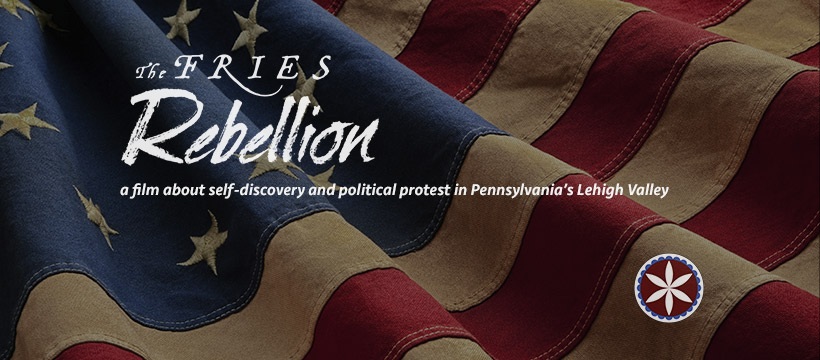Learn about the Fries Rebellion of 1799 — a pivotal moment in Lehigh Valley history. Explore heritage sites and museums that bring this early American story to life.
The Fries Rebellion (1798–1799) was an uprising led by John Fries (pronounced "freeze"), a local auctioneer and Revolutionary War veteran, who rallied Pennsylvania farmers to protest a federal property tax put in place by the administration under President John Adams. Centered mainly in today's Macungie Township and surrounding areas, the movement reflected the growing pains of a young nation balancing both liberty and law.
In anticipation of America250, the Lower Macungie Township Historical Society (LMTHS) produced a special 32-minute film delving into the Fries Rebellion. The film is set to be distributed nationwide via streaming services, film festivals, in museums and historical societies, and for tourism groups from around the world. The film provides insights into the ongoing, unfolding American experiment, highlights aspects of local heritage.
Several of the scenes feature original sites that still exist, including the Red Lion Inn (formerly Enoch Robert's Tavern - Quakertown), Jamision Publick House (formerly Conrad Mark's Tavern - Geryville), Hendrixson's furniture store (formerly John Shymer's Tavern - Shimersville), Buckeye Tavern (formerly Henry Shankweiler's Tavern - Macungie), 1760 House (formerly Peter Trexler's Tavern - Trexlertown), Commix Hotel (formerly Martin Ritter's Tavern - Allentown), and the 1758 Sun Inn (Bethlehem).

Take a self-guided tour and visit all the historically relevant locations below that are tied to the Fries Rebellion around Western Lehigh Valley!
(3741 Brookside Rd., Macungie, PA)
The Buckeye Tavern, established in 1735, served as an inn and hotel, providing food, warmth, and shelter. It was here that Henry Shankweiler’s attempted capture by Marshal Nichols was foiled during his escape to the barn, where threats were made against assessors Eyerly and Balliet.
(152 E. Main St., Emmaus, PA)
The Knauss Homestead is a historic site with deep roots in the region’s early settlement. Built in 1777, by Heinrich Knauss for his father Sebastian Knauss, it was used for the film scenes where Jacob Schaeffer fled the soldiers and his wife Catherine had her baby.
(3245 W. Emaus Ave., Allentown, PA)
Originally constructed as a stone tavern in the Germanic style. Martin Ritter, the proprietor at the time, played a significant role during the Fries Rebellion. On March 7, 1799, Ritter's Tavern served as a rallying point where Captain Henry Jarrett and a group of dissenters convened before marching to Bethlehem to join the protest.
(564 Main St., Bethlehem, PA)
In early March 1799, U.S. Marshal William Nichols used The Sun Inn as his headquarters and a temporary jail for individuals arrested for resisting the tax. On March 7, 1799, John Fries led a group of approximately four hundred armed men to the Sun Inn, successfully negotiating the release of the prisoners. Fortunately, no deaths occurred.
(5047 Hamilton Blvd., Wescosville, PA)
Constructed around 1790, this historic structure is a prime example of Pennsylvania German log architecture. Originally, it stood near Henry Bortz's two-story stone inn along the old stage road. It is cared for by the Lower Macungie Township Historical Society.
(3120 S. Cedar Crest Blvd., Emmaus, PA)
The center is dedicated to preserving and showcasing the rich history of Lower Macungie Township. It was named in honor of historians Ann and Craig Bartholomew for their significant contributions to society and the greater Lehigh Valley area. The museum offers exhibits on various aspects of local history, including architecture, technology, domestic arts, and Pennsylvania German culture. It is open to the public on Sundays from 1 to 4 p.m.
(55 S. Keystone Ave., Emmaus, PA)
The 1803 House is a stone home built in 1803 by Jacob Ehrenhardt, Jr., for his wife Susanna and their four daughters. The house is Federal-style architecture and offers insight into the early 19th-century Moravian lifestyle. The house was constructed four years after the rebellion. In 2024, it served as a filming location for the docudrama, with the 1803 House standing in for the 18th-century Schaeffer farm.
(1175 Trexlertown Rd., Trexlertown, PA)
1760 Pub N Grille began as a log house in 1731, forming the southern portion of the current building. Recognizing the need for a local gathering place, John Trexler applied for a license to operate a tavern on this site. The request was granted, and a license was issued by King George II of England. Judge Henry met with Jarrett and Eyerly here to obtain depositions from the rebels.
(601 South 4th St., Emmaus, PA)
The Shelter House is a historic log cabin constructed about 1734, the oldest continuously occupied structure in both Emmaus and the Lehigh Valley. Throughout its history, the Shelter House served as a stopover for travelers along a well-traveled Native American path. In the film scenes, it represented Peter Trexler’s Tavern.
(5386 Chestnut St., Emmaus, PA)
Revolutionary War Veteran, and justice of the peace John Shymer [Shimer] was the owner and innkeeper of this circa-1770 tavern. On January 3, 1799, over 80 rebels met here to draft and sign a petition for Congress to repeal the tax law, and assessors Heckewelder and Eyerly were threatened. The interior of the Jamison Publick House represented Shymer’s Tavern in the film.